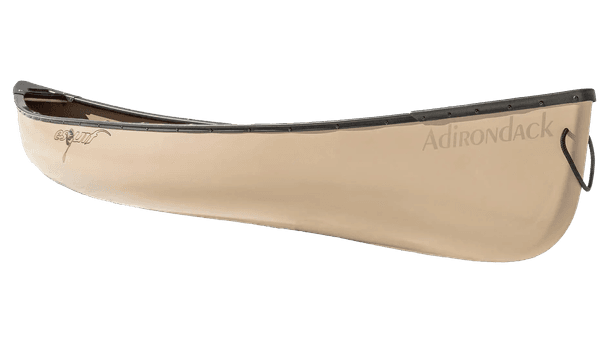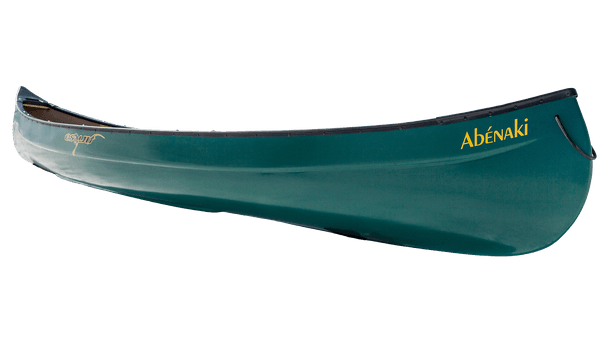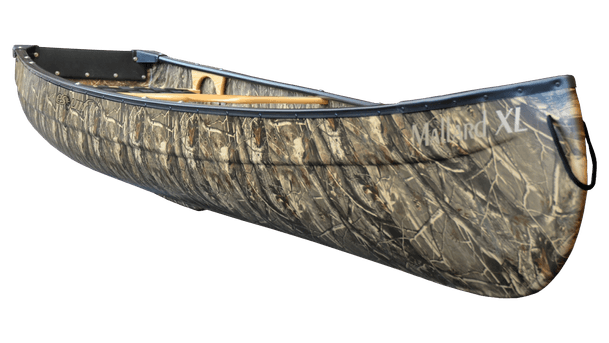- Home
- Gear & Reviews
- Prospector 16
Prospector 16

Prospector 16 Description
The original Prospector was a river-running boat known as the work horse of the North. This proven down river hull is our version of the classic design, and the closest thing to the original that money can buy. It's a stable hull for rivers and streams - with ample rocker it's quick to turn. Because of the symmetrical shape of the hull, a solo paddler loaded with gear could make good progress by turning around in the bow seat and paddling it backward.
Prospector 16 Specs and Features
- Structure: Rigid / Hard Shell
- Seating Configuration: Solo, Tandem
- Ideal Paddler Size: Average Adult
- Skill Level: Beginner, Intermediate
- Ideal Paddler Size: Average Adult
- Skill Level: Beginner, Intermediate
Wenonah Canoe, Inc.
Prospector 16 Reviews
Read reviews for the Prospector 16 by Wenonah Canoe, Inc. as submitted by your fellow paddlers. All of the reviews are created and written by paddlers like you, so be sure to submit your own review and be part of the community!
This is an addendum to our…
This is an addendum to our review of 9/17/15 in which we rated the Wenonah Prospector 16 ultralight very highly. In that review we promised to write an addendum once we had more experience poling the vessel.
We regret to report that we have found the Prospector 16 ultralight to be a very poor poling boat. It is very unstable and we have had difficulty keeping it aligned with strong currents. We even capsized while poling across Merrymeeting Bay in shallow water earlier this week due to these problems. It was our first capsize while canoeing after 40 years of paddling together if we exclude rescue drills.
The poor poling qualities of the boat came as a surprise to us since we have had good success with the Prospector 15 in Royalex. Although the Prospector 15 is a shorter boat, it is wider and more stable. It handles well poling in rapids, waves and on windy bays. We have written a report on a standard poling test we have conducted for four boats in an addendum to our review of the Prospector 15 for those who want to explore this issue further.
I recently purchased a…
This is a review for the…
My wife and I portage our boats a great deal and so the Wenonah ultralights seem like a gift from heaven. Nonetheless, we have found the Prospector 16 in kevlar ultralight to be an especially versatile and capable boat for many types of paddling.
We purchased the canoe in April and have paddled it in two main types of environments so far. These include the narrow bays and tidal rivers of the midcoast region and the small streams and beaver ponds farther inland. Missing so far from our test runs are big lakes and open ocean.
Our average speed on calm water is 3.6 mph. On the coast, in spite of the wind and tides, our average speed so far is still 3.5 mph. See the table below. This makes the Prospector 16 the fastest boat we have ever owned.
-
Table of Average Boat Speeds, Mph, Coastal Maine
- Wenonah Prospector 16, Kevlar Ultralight: 3.5
- Wenonah Escape, Fiberglass/polyester: 3.4
- Prospector 15, Royalex: 3.3
- Old Town Tripper, Royalex: 3.0
- Wenonah Aurora, Kevlar Ultralight: 2.7
With coordinated stroking, the Prospector can be headed into the wind and waves and held on course quite easily with minimal correction. As wind speed and wave size increase, however, one paddler should keep a blade in the water while the other takes his out for another stroke. This sacrifices some speed in favor of stability and control, but this is true for all canoes.
We have found that the Prospector handles best with the total load from people and gear centered just aft of the main thwart. For example, since I weigh more than my wife and I paddle from the stern, we maintain proper trim by placing most of our gear forward in the boat, just behind the bow seat. We have not needed ballast so far to achieve proper trim as we have in other boats.
The canoe is superb in quick water and Class l and ll whitewater. With its rocker and symmetrical hull, it can be paddled backwards and sideways easily or turned on a dime. We have no problem turning in and out of eddies. The boat just bounces off pillows of water tumbling over rocks if we come too close and we can slide up to and pass haystacks with no effort at all.
The Prospector is not designed for Class lll rapids or charging over Class 1V drops. It can probably handle these conditions but it is probably best to use a whitewater boat instead.
The Prospector hull originates in theory from the Chestnut Canoe Company in Fredericton, New Brunswick. Kenneth Stolway, a Canadian writer, indicates that the earliest reference to the hull is from the company's catalog in 1923. The Prospector gained a fabulous reputation based on the writings of outdoor writers, but Stolway thinks the reputation is not deserved. He says the original boat had too much rocker and was susceptible to being swept sideways in strong winds.
My wife and I have not found this to be a problem with the Prospector hull as it has been adapted by Wenonah. On the contrary, in gusts up to 15 mph and waves up to a foot high it has handled very well.
We have poled this boat only once so far on a short stretch of quick water between beaver dams. It seems to pole very well, just like its smaller cousin, the Prospector 15, which we own in Royalex. We will write an addendum to this review if necessary once we gain more experience poling the Prospector 16.
All in all, my wife and I find this to be a superb canoe. For our purposes, it is clearly the best canoe we have ever owned.
Used primarily on combination…
I love my Wenonah canoe. I am…
It is durable and roomy enough to put a third seat in the middle if desired. I just paddled the boat from the bow in reverse. I have had this boat for years, and though it has some scars of use, it is incredibly durable, maneuverable and worthy of its 10 rating.
I've been paddling for a good…
16' RX version, rigged for solo use. This canoe was purchased and outfitted…
This canoe was purchased and outfitted for poling, though at the last minute I did weaken and fitted a seat. As a base for poling it is proving to be excellent. Some might prefer something with more initial stability when standing up, but I like the lively feel of it, and there is enough width in the centre to take a comfortable stance. The secondary stability is superb: I often dip the gunwales to squeeze through narror gaps between rocks and it feels even more solid there than when upright. The real beauty for poling though is that 4" of rocker, which is a lot for a 16' traditional canoe. This amount of rocker makes for a slow, relatively poor tracking hull, but for me this is not important when poling. What is important is that the stems do not catch in the current. This feature means that the need for trimming is less significant than in other canoes I have poled and permits some very tight turns to be made, and powerful ferry glides too.
I recently used the boat for a flatwater trip. This would never be a first choice canoe for flat water. It is very poor on the flat, the very high ends and that 4" rocker are completely counterproductive.
I have paddled it (as opposed to poled) a bit of class 3 and as a solo rig it works very well. No other 16' canoe I have paddled is as responsive, and the ride is smooth, predictable and dry. (The same cannot be said for paddling tandem: tandem folk would be much better served in the Rogue. The Prospector's narrow ends give a wet ride tandem unless you come off the seats into the centre of the boat)
As a poling canoe I'd give it 9 /10 (the ends are excessively high really, otherwise it would be 10.)
However, rating it as an over-rounder, only 6 or 7 because of that awful flatwater 'performance'. But I love this canoe for what I use it for, and it is seeing more and more use!
I purchased a Prospector 16…
I recently purchased a…
I have a Bell kneeling thwart installed in place of the stern thwart. This places you closer to center than paddling from the bow seat with the canoe reversed. I've paddled on the Green River in Utah for a day paddle as well as a few days paddling on other reservoirs in Utah. Paddling from the kneeling thwart with about 40-50 lbs. of gear in front of me between the carrying thwart and the bow seat, really seems to be the best way to paddle this canoe in up to 10 knot winds. I had absolutely no problems at all keeping pointed in whatever direction I wanted to go. The Prospector 16 is listed in Wenonah's catalog as having 4 inches of rocker. Paddled from the kneeling thwart is the way to go in windy conditions. The kneeling thwart is mounted at a height of 11.5 inches from the floor of the canoe. This seems to be a good height for me. I'm 5'11" tall, 32" inseam. and weigh 200 lbs. My weight is equally distributed between my butt and knees at this height. I'm using a 1/2" foam pad to kneel on. From the kneeling thwart, I'm using a 58" straight paddle. I have experimented with paddling from the bow seat with the canoe backwards. The "front" edge of the seat is 9.5 inches high. I sat for the most part. I tried kneeling from here and could do it, but I would want to raise the seat up a bit if I plan to paddle from here. I had the same gear as previously mentioned, in front of me, on the other side of the carry thwart. The wind was around 10 knots, and it did effect the canoe a bit, and want to blow the bow down wind. I would recommend paddling from a kneeling thwart, although both positions work. From a sitting position I'm using a 54" straight paddle. It seems to me that what length of paddle you use, depends mostly on if your going to sit or kneel. I suppose I could split the difference, and just get a 56". From either position, sweep strokes as well as j-strokes work very well. As I stated, my preference is to paddle from the kneeling thwart. This puts my knees on the floor about 12" behind center. Only minimal effort is required on windy days to keep my canoe tracking straight. I usually paddle on my right side, I slide over on the thwart a couple of inches, to be closer to the gunwhale. this only leans the canoe slightly. Practice your j-strokes, and you can easily make a rockered canoe track straight, and you still have all of the advantages of maneuverability. A canoe with no rocker at all will actually resist your corrective strokes. That's why I mention the fact that it only takes minimal effort to keep everything straight. On the day I paddled on the Green River, there wasn't any wind to speak of, it was relatively flat water, but moving very fast at 12,000 cubic ft. per second. It was a bit of work to paddle against the current, I experimented with paddling at angles to the current to cross from one side of the river to the other. A rockered canoe really shines when it comes to maneuvering around the river. I tried to same thing going down river, and found it just as controllable, and less work of course. When leaning the canoe in the currents, I found the Prospector to really stiffen up. It seems to have a very good secondary stability. I wanted a tandem canoe that would handle well as a solo canoe. As well as be versatile enough to paddle everything from class 2 rivers, wind blown lakes, and still water with no wind. And still be able to serve well as a tandem.I can't give any feedback on paddling tandem, as I haven't done it yet. I can't imagine any real shortcomings there. Although, if I were going to strictly use a tandem canoe only as a tandem, with kids and a bunch of camping gear, then I would look for an 18' Wenonah Champlain, Bell Northwoods or a Souris River Quetico 18.5. The 16' Prospector fits the bill for me,and handles all of the above mentioned conditions very well. I rated it an 8, because paddling a tandem as a solo is a compromise compared to paddling a dedicated solo canoe. I really had my eye on a kevlar Wenonah Rendezvous 15'8" solo, they're only available from "Canoe Colorado". But I needed the extra room for kids. The Prospector was my choice, I'm very happy with it.
Garcreek has it right. In…
The best handling US made tandem river boat yet. A joy to trip, to fish from, reasonably fast and good lookin' enough to take your lady out for a date. For the Boundary Waters and extensive lake use get another boat. This one will do it but not as light or fast as some others. But, if you can have only one boat to do it all, this is it.
As a vote for moving waters, just plain paddling fun, and tripping in the North.
This is the best all around…
The only slight problem that I see is on long, flatwater trips on lakes. It really gets about a 7 on a scale of 1-10 on the flatwater and that is why it is not a 10 overall. It really is a 10 for 90% of people. I guess that you can't have it all.
At $1099 MSRP for the Royalex lay-up, I think it is the best value on the market. I have had mine for 2 years now and I use it so much that it has paid for itself already and I still have a lifetime to use it.
You can mark my words that the Prospector 15', 16', and 17' will be talked about years down the road as being some of the best boats ever. I suggest that you go out and get one ASAP so that you can be as happy as I am.
I could go on and on about this boat and I really mean it.





